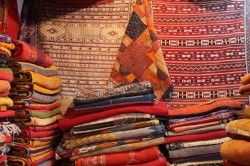Natural carpet flooring – What you need to know about it
In our third article about different bio-based floorings we take a closer look at bio-based carpet fibres. Many people appreciate the good old carpet, which also invites you to sit on the floor. Carpet fibre is warm and soft to the feet and there are almost no limits to the design. What types of carpet fibres are available? A carpet is a textile floor covering typically consisting of an upper layer of pile (upright loops or strands of yarn) attached to a backing. Carpet fibres can be classified into natural (bio-based) fibres and synthetic fibres. Only about 10% of textile floor coverings are made of natural materials such as wool and goat hair, wool-synthetic blends, sisal (made from the agave plant), coconut, seagrass, jute or cotton. Around 90% of textile floor coverings are made of synthetic fibres such as polyamide, polyester or polypropylene. They are used because they have the technical properties necessary for hotels, offices and public institutions. So far, these high technical requirements (flame and moth protection) can usually only be achieved with massive chemical retrofits that harbour health risks. What are the advantages of natural carpet flooring? Natural fibre carpets improve the indoor climate particularly well. They balance humidity and ensure a comfortable indoor climate. According to scientific studies, wool carpets can even absorb and neutralise indoor air pollutants such as formaldehyde. Wool absorbs up to a third of its weight in moisture and has a natural protection against staining due to the residual fat (lanolin) contained in the yarn. Natural carpets always feel warm and have a high level of walking comfort. They barely charge up static and have good sound insulation properties. And in addition, natural fibre carpets do not make use of fossil resources as they are made from renewable raw materials. Sisal is particularly tear-resistant, heat-insulating and flame retardant. The fat-free nature of the coconut fibre does not provide a breeding ground for bacteria, so coconut-based carpets are antibacterial and abrasion- and tear-resistant. With regular cleaning (vacuum cleaner with highly efficient filter), carpets can be more advantageous for house dust-allergic persons, because the dust is bound in the carpet and cannot be stirred up as easily as on hard surface flooring. What are the disadvantages? There is no general answer. Each fibre, no matter if natural or synthetic, has certain properties with advantages and disadvantages. The choice of the best material depends on your personal preferences and expected use. Some sources say that bio-based carpet fibres are not as easy to clean as conventional ones. Is bio-based carpet fibre healthier? It is important to know that carpets can be a mixture of synthetic and natural materials. Whether a carpet is free of pollutants is not easy to recognise, because there are no binding quality labels for such products made of natural fibres. Often, additives for flame retardants and moth protection are used for the front and back coating. That’s why you can even find natural fibre carpets with a completely synthetic backing and a typical “new smell”. Therefore, you should check with your carpet retailer what additives have been used and whether a certification is available. Only a few manufacturers pay attention to materials made of renewable raw materials for the carrier material and the pile and carrier bonding. Read more here: http://www.allthings.bio/natural-carpet-flooring-what-you-need-to-know-about-it/(opens in new window)
Countries
Germany, France, Netherlands, United Kingdom



